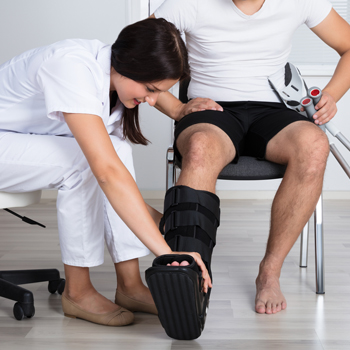
Did you know that bicycling resulted in more than 425,000 injuries in 2020 alone? And while sports injuries are common in the summer, winter isn’t a safe time of year either. Sledding alone causes more than 700,000 injuries per year, and snowboarding tops the list for one-quarter of all sports-related ER visits — half of which involve broken bones, often the wrist. Any time you have a traumatic injury — whether from a recreational activity gone wrong or a car accident — there is a chance of a rare but serious complication known as compartment syndrome. It’s estimated that compartment syndrome occurs in 7.3 per 100,000 in males and 0.7 per 100,000 in females, with the majority of cases occurring after trauma. Keep reading to learn the six Ps that could mean your patient has compartment syndrome.
What is compartment syndrome?
Compartment syndrome occurs when elevated pressure within a compartment of the body results in an insufficient amount of blood to supply the muscles and nerves with oxygen. This can occur in any enclosed space of the body, but most often occurs in the anterior compartment of the lower leg or the forearm. It can also occur in the hands, feet, abdomen, and buttocks.
If unrecognized or untreated, compartment syndrome can lead to irreversible damage and death of tissue within the compartment and sometimes even more serious conditions, including rhabdomyolysis (the rapid destruction of skeletal muscle) and kidney failure.
Warning signs of compartment syndrome
Check out the six P’s of compartment syndrome below for warning signs to watch for:
1. Pain. While this is expected with a muscle injury, pain described as deep and constant and poorly localized, that increases when stretching or manipulating the muscle, and is unrelieved by pain medications is not normal and could be a sign of compartment syndrome.
2. Pallor. If you notice that your patient has pale, shiny skin, especially distal to the injury site, report the symptoms to a doctor immediately.
3. Pulselessness. A diminished or absent pulse in an affected area can be caused by compartment syndrome, which creates a tourniquet-like effect and cuts off circulation to the limb.
4. Paresthesia. The patient may experience a pins-and-needles sensation, tingling, tickling, prickling or burning.
5. Paralysis. Though this is usually a late finding, paralysis or numbness in a limb can be a sign of compartment syndrome. This is most common when a patient’s leg or arm has been crushed in an accident.
6. Poikilothermia. This term, which refers to a body part that regulates its temperature with surrounding areas, is an important one. If you notice a limb that feels cooler than surrounding areas, the patient may have compartment syndrome.
Treatment for compartment syndrome
Should you discover any abnormal symptoms that suggest a serious problem, report them to a doctor immediately. He or she will measure the pressure in the compartment with an IV catheter and needle. If the patient is suffering from compartment syndrome, a fasciotomy is required — slicing the skin and fascia covering the affected compartment to reduce pressure and increase blood flow.
For more information on compartment syndrome, check out these resources:
You may also be interested in: 7 tips for working with distressed family members
Article last updated 02/02/2022











